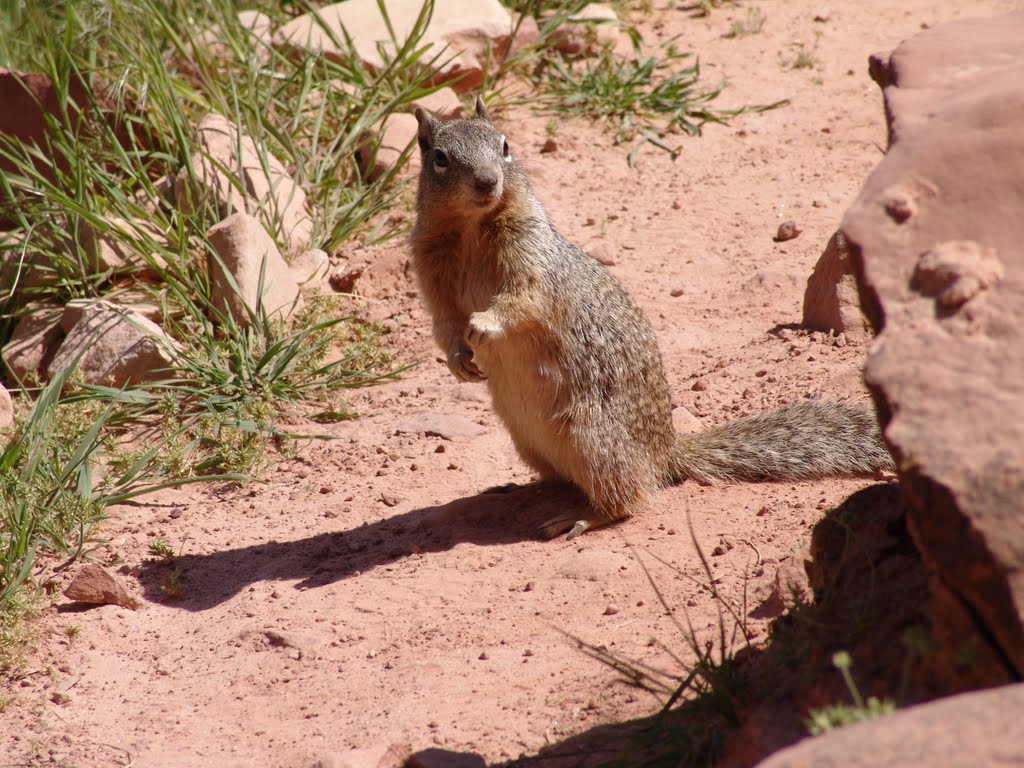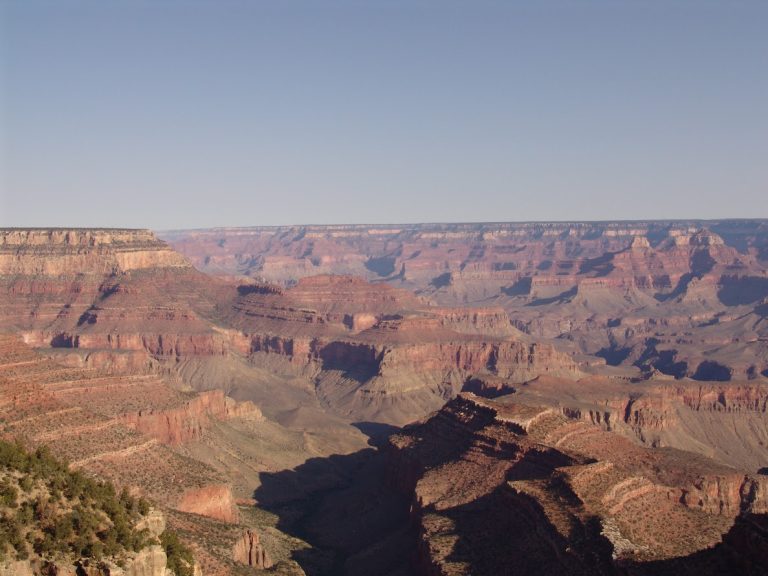Welcome to our page dedicated to Grand Canyon facts! The Grand Canyon is one of the most breathtaking natural wonders of the world, attracting millions of visitors each year from all over the globe. Located in Arizona, USA, this awe-inspiring landmark offers a wealth of fascinating facts and interesting information that is worth exploring. From its formation and geology to its diverse wildlife and cultural significance, the Grand Canyon is a true marvel of nature that continues to inspire and amaze people of all ages. Join us as we delve into the fascinating world of Grand Canyon facts and discover some of the most incredible aspects of this iconic natural landmark.
Quick facts about the Grand Canyon
- The Grand Canyon is a chasm 277 miles long and up to 18 miles wide.
- Right below Yavapai point, the Grand Canyon is 2,400 feet above sea level, about 4,500 feet below the South Rim and 5,400 feet below the North Rim.
- The canyon took 3-6 million years to form. Even today, erosion continues to alter its contours.
- The Grand Canyon includes about 70 species of mammals, 250 species of birds, 25 types of reptiles and five species of amphibians.
- The canyon was formed by the mighty Colorado River, which flows west through the canyon and averages about 300 feet in width, 100 feet in depth and flows at an average speed of four miles per hour.
- The Grand Canyon National Park was made a national monument in 1908 and became a national park in 1919.
- The national park covers an area of about 1,900 square miles and is 190 miles long.
- The park contains about 277 miles of the Colorado River.
- The Grand Canyon national park is populated by five Indian tribes:
The Hopi, Navajo, Havasupai, Paiute and Hualapai
What you need to know about the Grand Canyon
The Grand Canyon National Park is bigger than French Polynesia.
The Grand Canyon national Park covers an area of about 1,904 square miles. That makes it bigger than French Polynesia (1,609 square miles) and almost as big as Trinidad and Tobago (1,980 square miles).
When comparing the Grand Canyon National Park to US states, we can say that it is bigger than Rhode Island (1,034 square miles) and almost as big as Delaware (1,955 suqare miles).
Temperatures vary greatly within the canyon.
The temperature at the Grand Canyon can vary greatly, with a difference of over 25 degrees between the rim and the lowest point. The depths of the gorge are particularly warm during the summer months, while the North Rim can experience freezing temperatures in the winter.
The Grand Canyon is full of caves.
The Grand Canyon is home to approximately 1,000 caves, with only 335 having been recorded and even fewer mapped or inventoried. At present, only one cave, the Cave of the Domes on Horseshoe Mesa, is open to the public.
These caves are unique and delicate resources that provide homes for various cave-dwelling wildlife, including vulnerable bat species. In addition to their ecological value, many of these caves also have an important role in regional hydrology, with stunning waterfalls and significant streams emerging from places like Vaseys Paradise, Cheyava Falls, and Roaring, Thunder, and Tapeats springs.
Under current park policy, all caves are closed to the public, except for research purposes. This is because Grand Canyon caves are fragile and require careful preservation. Mineral formations, fossil bones of extinct animals, and prehistoric artifacts have all been discovered within these caves, making them a truly special and irreplaceable resource within Grand Canyon National Park.
The Federal Aviation Administration (FAA) was created because of the Grand Canyon.
During the 1950s, commercial airplanes frequently took detours over the Grand Canyon to allow passengers to marvel at its beauty. However, on June 30th, 1956, two of these planes collided tragically with no survivors. This devastating event prompted the federal government to establish the Federal Aviation Administration (FAA) to regulate and oversee air travel safety. More information on this crash can be found on Wikipedia.
The Canyon is still changing shape.
For millions of years, the Colorado River has been carving its way through the Grand Canyon, slowly but surely shaping the majestic landscape we see today. The forces of erosion, wind, and rain have all played their part in sculpting the canyon walls and creating its unique features, such as the steep cliffs, jagged peaks, and winding canyons.
While the changes to the Grand Canyon may occur at a glacial pace and be imperceptible to the naked eye, they are still happening. The river’s flow carries sediments downstream and reshapes the canyon’s contours, while wind and rain continue to carve away at the rocks, creating new formations and eroding old ones.
Over time, these forces have created some of the most spectacular sights in the world, such as the towering walls of the inner gorge, the dramatic cliffs of the South Rim, and the sweeping vistas of the North Rim. And while we may not be able to witness the changes happening in real-time, they serve as a reminder of the incredible power of nature and the ever-evolving beauty of the Grand Canyon.
The air at the Grand Canyon is cleaner than almost anywhere in the US.
One of the lesser-known but incredibly valuable assets of the Grand Canyon is its clean and fresh air. In fact, the air at the Grand Canyon is considered to be among the purest in the United States. Due to the canyon’s remote location and low population density in the surrounding areas, the air is free from the pollutants that are found in more urbanized areas.
This pristine air quality not only contributes to the natural beauty of the area but also provides significant health benefits for visitors. Breathing in the fresh air can help to reduce stress, improve respiratory function, and promote overall well-being.
In addition, the clear air at the Grand Canyon enhances the visibility of the breathtaking views, allowing visitors to see the majestic canyon in all its glory. The purity of the air also contributes to the stunning sunrises and sunsets that are a hallmark of the Grand Canyon experience.
You can view the live air quality data of the Grand Canyon on the NPS website.
To have a look at how clear the air is, you can also check out the webcams at the Grand Canyon.
The Grand Canyon’s huge mystery: The Great Unconformity.
The Great Unconformity is one of the most intriguing geological features found at the Grand Canyon. It refers to a major gap in the rock record that spans over a billion years of Earth’s history. At the base of the Grand Canyon, there is a layer of rock called the Vishnu Basement Rocks that are over a billion years old. Above this layer, there is a significant gap in the rock record that spans around 300 million years. This gap is known as the Great Unconformity.
Above the Great Unconformity lies a series of sedimentary rocks that are much younger than the Vishnu Basement Rocks. The Great Unconformity represents a significant period of Earth’s history where no sediment was deposited on this area. Instead, the exposed rocks were subjected to erosion and weathering, which led to the formation of a flat surface.
The Great Unconformity is a significant geological feature because it marks a critical turning point in the history of our planet. The rocks below the unconformity are some of the oldest rocks on Earth, and their exposure at the Grand Canyon provides valuable insight into the processes that shaped the early Earth. The unconformity also signifies a significant change in the Earth’s surface processes, from a period of stability to one of frequent change and upheaval.
Today, visitors to the Grand Canyon can see the Great Unconformity at several points throughout the park, where the rocks of different ages meet. This geological feature serves as a reminder of the ever-evolving nature of our planet and the power of the natural processes that continue to shape it over time.
The most dangerous animal at the Grand Canyon is the Rock Squirrel!

The Grand Canyon is a habitat for a diverse range of wildlife, including bighorn sheep, California condors, and Gila monsters. However, it is the rock squirrel that poses the greatest risk to visitors. Each year, dozens of people are bitten while attempting to feed these animals, which can be dangerous and aggressive.
To ensure your safety while visiting the Grand Canyon, it is important to remember not to approach or feed any of the animals you encounter. While it may be tempting to get closer or offer food, doing so can put both you and the animals at risk. It is also important to remember that feeding wild animals can be harmful to their health and disrupt the natural balance of the ecosystem.
There is a town inside the Grand Canyon.
Supai is a small community located within the Grand Canyon in Arizona, USA. It is the capital of the Havasupai Indian Reservation and is home to approximately 500 members of the Havasupai Tribe. The village can only be reached by hiking, horseback riding, or helicopter, making it a unique and secluded destination for visitors.
One of the main attractions in Supai is Havasu Falls, a stunning 100-foot waterfall located just outside the village. The falls are known for their turquoise blue waters, which are caused by the high concentration of calcium carbonate in the water. Visitors can hike to the falls and swim in the natural pools at the base of the waterfall, making for a refreshing and memorable experience.
In addition to Havasu Falls, Supai is also home to other natural wonders, including Mooney Falls and Navajo Falls. Visitors can explore the beautiful scenery of the Grand Canyon by hiking or horseback riding along the trails that wind through the area. Camping is also available for those who want to immerse themselves in the natural beauty of the Havasupai Reservation.
